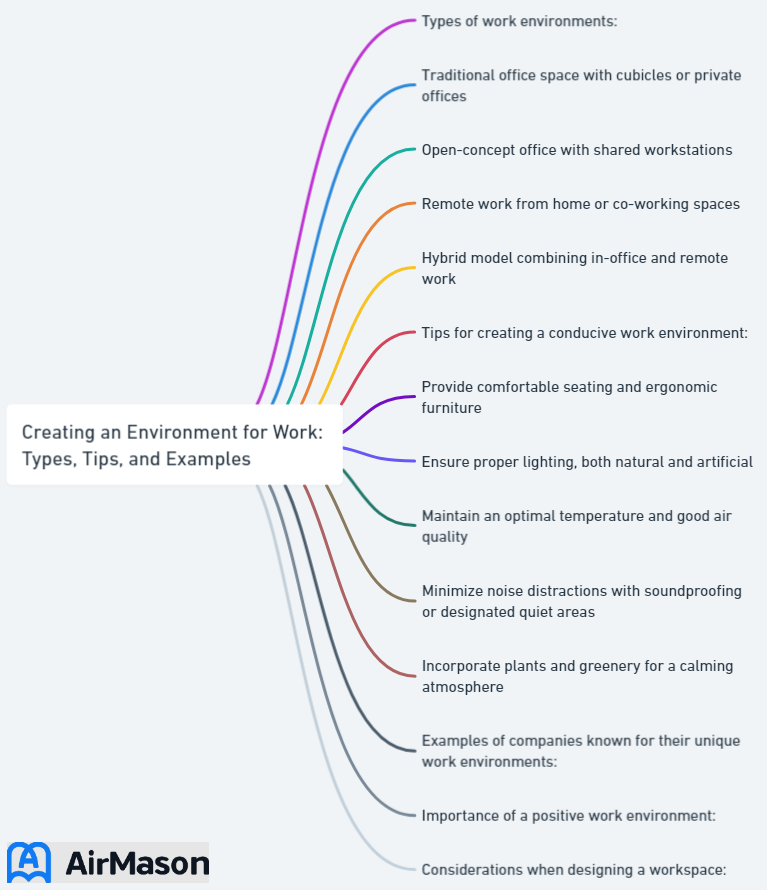
Have you ever wondered how some organizations consistently maintain high employee satisfaction rates and productivity levels? The secret lies in their ability to create a positive environment for work. This article will explore the different types of work environments, key components of a successful workplace, and practical tips on how to establish a stimulating and nurturing atmosphere for your employees. So, let’s dive in and discover how to create an environment for work that fosters growth, collaboration, and overall happiness.
Key Takeaways
- Create a nurturing work environment that values colleagues and invests in physical aspects, organizational culture, and flexible work arrangements.
- Employers can craft impactful job descriptions, invest in employee development, encourage open communication & recognize/reward employees to create a positive atmosphere.
- Focus on employee well-being & recognition of achievements for an engaging workplace that unlocks potentials.
Understanding Work Environments
A positive work environment is an exciting and stimulating setting where employees can perform their jobs to the best of their abilities, benefiting from comfortable physical conditions and positive social aspects. Work environments can greatly enhance job satisfaction and productivity, making them crucial to the success of any organization.
A variety of uplifting and encouraging environments help employees thrive. When a company culture appreciates and values colleagues at all levels, it significantly enhances both workplace satisfaction and overall performance. Indeed, a nurturing work environment encompasses various aspects, including physical space, organizational culture, and work arrangements.

Types of Work Environments
Different types of work environments cater to various employee preferences and organizational needs. Some common types include traditional, flexible, remote, collaborative, and creative environments. A traditional work environment typically consists of a conventional office space with set working hours and a hierarchical structure. In contrast, flexible work environments offer more adaptable work hours, remote work options, and the opportunity for employees to create their schedules, providing a different type of environment.
Collaborative environments encourage teamwork and open communication, while creative work environments foster innovation and artistic expression. Understanding an organization’s unique requirements and adapting accordingly is a fundamental step in creating a positive work environment. Choosing the appropriate work environment can set organizations up for long-term success by boosting employee satisfaction, productivity, and retention.
Understanding an Organization’s Culture
An organization’s culture, often referred to as its corporate culture or workplace culture, is a critical component that significantly influences its overall identity and operations. The culture of an organization encapsulates the shared values, beliefs, traditions, and behaviors that define its character and shape the way employees interact and perform their roles. This culture is not something that can be easily replicated or imposed; rather, it evolves over time through the collective experiences, attitudes, and leadership of those within the organization. A strong and positive organizational culture can foster collaboration, innovation, and employee engagement, driving the organization towards its goals and objectives. Conversely, a dysfunctional or toxic culture can hinder productivity, erode employee morale, and impact the organization’s overall success. Thus, understanding and actively managing an organization’s culture is crucial for creating a harmonious and successful work environment.
Key Components of a Positive Work Environment

Creating a vibrant, successful work environment requires a focus on key components like physical aspects, organizational culture, and work arrangements. Addressing these elements cultivates a positive work atmosphere, encouraging productivity, creativity, and employee happiness.
Each of these components contributes significantly to a thriving workplace, warranting a more in-depth examination.
Physical Aspects
The physical office environment plays a significant role in creating a comfortable and efficient work setting. Factors such as:
- An ergonomic layout
- Modern equipment
- Appropriate noise and lighting levels
- Pleasant temperature and ventilation
- High safety standards
All contribute to creating a healthy environment within the work environment.
Moreover, proper lighting can enhance workers’ performance and morale, preventing the development of a toxic work environment. Employers who prioritize the physical aspects of the workplace foster an environment conducive to success and employee well-being.
Organizational Culture
A strong organizational culture fosters a positive work atmosphere by promoting a clear mission statement, open communication, and meaningful connections among employees. Communication is invaluable in creating an inspiring workplace environment, as it encourages employees to feel appreciated and energized.
Maintaining open communication in the workplace promotes collaboration and strengthens relationships among colleagues, fostering a supportive and collaborative environment. In addition, a positive workplace culture has been shown to increase employee retention, productivity, and innovation, making it a great investment for any organization.
Companies Culture
Companies culture plays a pivotal role in shaping the work environment and overall ethos of an organization. It encompasses the shared values, beliefs, and behaviors that define how employees interact and collaborate within a company. A positive companies culture fosters a sense of belonging and encourages employees to give their best, driving productivity and innovation. When a company prioritizes a healthy work culture, it not only attracts top talent but also retains them in the long run. Moreover, a well-defined companies culture sets the tone for decision-making, providing a framework for employees to align their actions with the company’s overarching goals. It acts as the cornerstone of an organization, influencing everything from internal policies to customer relations.
Work Arrangements and Flexibility
Flexible work arrangements offer an excellent opportunity to improve work-life balance and employee satisfaction. Offering flexible work hours, remote work options, and other adaptable arrangements allows employers to cater to the diverse needs and preferences of their employees.
Flexible work schedules have been shown to have several benefits, including:
- Significantly improving productivity levels and morale
- Potentially leading to cost savings and improved attendance
- Helping organizations foster a positive and inclusive work environment
Creating a Conducive Work Environment: Practical Tips

We’ve explored the key components of a positive work environment; now for some practical tips on creating an uplifting and nurturing atmosphere for your employees. These actionable suggestions include:
- Crafting impactful job descriptions
- Investing in employee development
- Encouraging open communication
- Recognizing and rewarding employees
Crafting Effective Job Descriptions
Clear and accurate job descriptions play a crucial role in attracting the right candidates and setting expectations for your company culture and work environment. Providing potential employees with an accurate and exciting overview of their future roles and responsibilities attracts candidates who are the right fit for your organization.
Job descriptions also play a vital role in reducing employee turnover and maintaining a stable work environment by establishing expectations for both the employer and the employee. Crafting effective job descriptions is an essential step in creating a positive work environment that fosters growth, collaboration, and overall happiness.
Investing in Employee Development
Providing training, mentorship, and growth opportunities to employees is crucial for creating a supportive and motivating work environment. Investing in employee development offers the following benefits:
- Empowers employees to reach their full potential
- Enhances their skills and knowledge
- Increases job satisfaction and engagement
- Improves employee retention
- Boosts productivity and performance
- Contributes to the organization’s success
Some exciting employee growth opportunities that can be implemented in a flexible work environment include:
- Online training sessions
- Webinars
- Book clubs
- Management and leadership training
- Professional certifications
- Mentoring programs
- Shadowing opportunities
- Lunch-and-learn sessions
Investing in employee development is an essential step in fostering a positive and nurturing work environment.
Encouraging Open Communication
Transparent and inclusive communication is crucial for promoting trust, collaboration, and a positive work culture. Encouraging open communication helps employees feel valued and appreciated, which leads to a more positive workplace environment.
Open communication can also help resolve workplace conflicts and promote collaboration among team members. By implementing effective communication tools, such as:
- Zoom
- Dropbox
- Airtable
- Microsoft Teams
Employers can encourage open dialogue and create a collaborative, supportive environment by providing constructive feedback.
Recognizing and Rewarding Employees
Regular recognition, feedback, and rewards can significantly enhance employee motivation, employee engagement, and overall satisfaction. Acknowledging employees’ efforts and achievements helps to create a positive work atmosphere that encourages growth and success.
Recognition can take many forms, from a simple “thank you” for a job well done to more formal rewards and accolades for exceptional performance. By demonstrating appreciation for employees’ hard work, employers can foster a supportive and motivating work environment that boosts morale and productivity.
Avoiding Common Work Environment Mistakes

Identifying and addressing common pitfalls is important for creating a truly positive work environment. Some common mistakes include neglecting employee well-being, poor communication, and lack of recognition. By being aware of these issues, employers can take proactive steps to foster a positive and nurturing work atmosphere.
Focusing on employee well-being, maintaining open communication, and acknowledging achievements are all great ways to avoid these common mistakes and create a supportive work environment. By addressing these challenges, employers can ensure that their workplace remains a positive and productive space for all team members.
Culture at Work
The concept of “culture at work” encompasses the shared values, beliefs, and behaviors that shape the environment within an organization. It defines the way employees interact, communicate, and collaborate, ultimately influencing the overall productivity and success of the company. A positive work culture fosters a sense of belonging and encourages individuals to bring their authentic selves to the workplace. It promotes open communication channels, allowing for constructive feedback and the exchange of innovative ideas. Additionally, a strong work culture aligns employees with the company’s mission and goals, instilling a sense of purpose and dedication. When carefully nurtured, a vibrant work culture can lead to increased employee satisfaction, higher retention rates, and ultimately, a thriving, dynamic organization.
Adapting to Changing Work Trends

In today’s fast-paced world, keeping up with evolving work trends is key for shaping a work environment that caters to the needs of a diverse and dynamic workforce. Adapting work environments to meet changing trends enhances employee satisfaction and productivity.
Keeping abreast of the latest work trends and implementing innovative solutions can help organizations create a positive and inclusive work environment. Staying informed and embracing change ensures that the workplace remains a supportive and engaging space for all employees, regardless of their preferences or needs.
Summary
In conclusion, creating a positive work environment is an essential aspect of fostering employee satisfaction, productivity, and retention. By understanding the different types of work environments, focusing on key components such as physical aspects, organizational culture, and work arrangements, and implementing practical tips for success, employers can establish a nurturing and motivating atmosphere for their employees. Stay adaptable, embrace change, and watch your organization thrive in today’s dynamic work landscape.
Frequently Asked Questions
What are the 3 types of work environment?
The physical and psychological conditions of the workplace determine the type of work environment. The three most common types of work environment are comfortable, traditional, and flexible; and two growing trends in the workforce are remote and modern work environments.
What are the 3 most important things in a working environment?
Creating a positive work environment based on respect, teamwork, training and communication, while providing opportunities for growth, is essential for success.
How do you answer the work environment?
I seek an environment that promotes collaboration, encourages professional growth and fosters the use and growth of my skills and qualities. From the research I’ve conducted, it appears the company has a culture that aligns well with what I am looking for in a workplace. I’m confident I can work both independently and as part of a team in this environment.
How can employers create a supportive and motivating work environment?
Employers can create a supportive and motivating work environment by focusing on workplace physicals, fostering positive culture, offering flexible arrangements, crafting effective job descriptions, investing in development, and encouraging open communication.
What are some ways to improve the physical aspects of the work environment?
Employers can create a healthier and more efficient work environment by implementing ergonomic office layouts, modern equipment, suitable noise and lighting levels, comfortable temperature and ventilation, and strong safety standards.